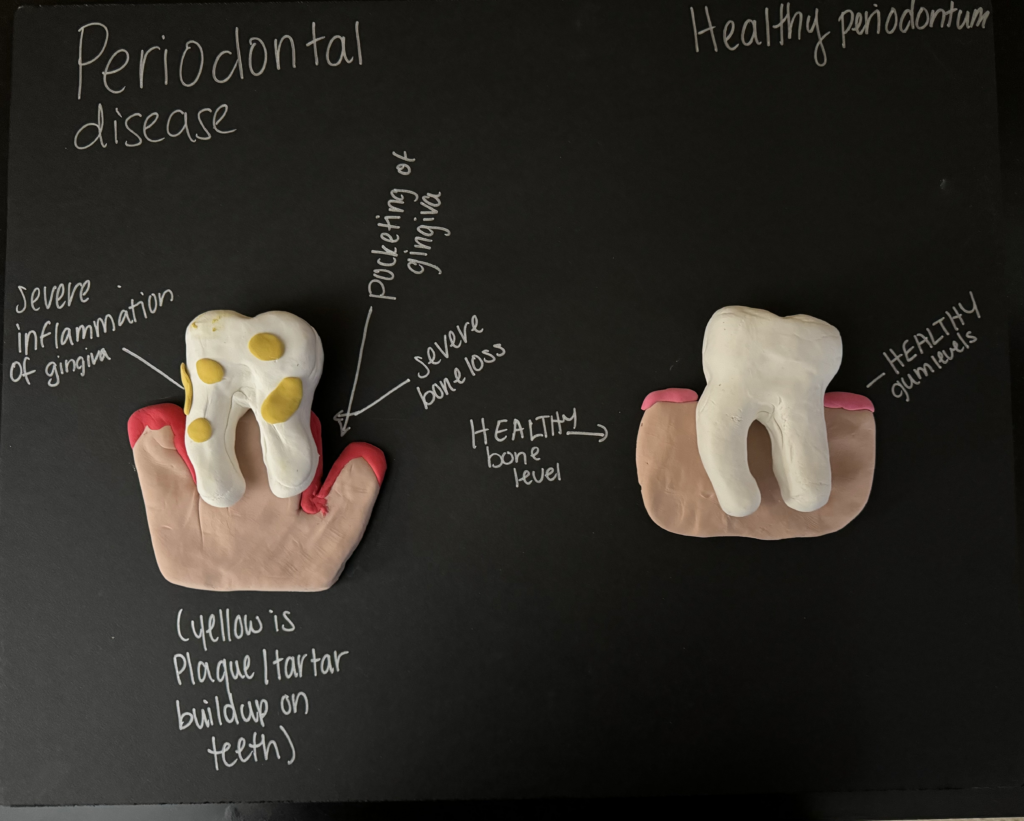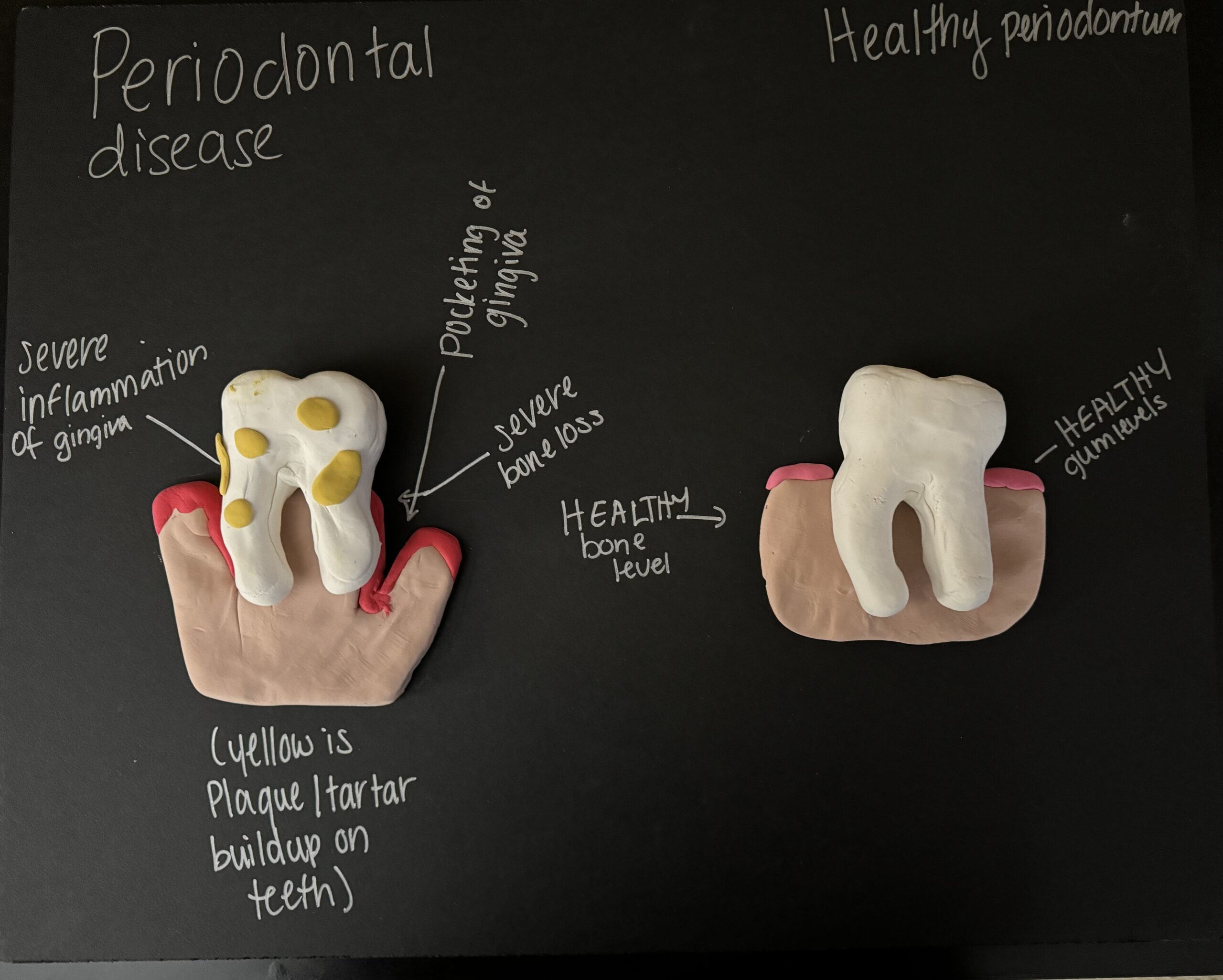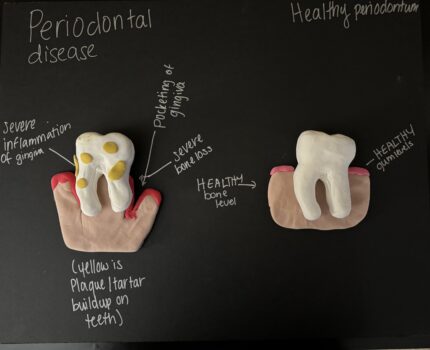
My project covers the objective “compare and contrast the function and structural characteristics of tissues”. More specifically, my project covers periodontal disease and its characteristics, diagnosis, and treatment. My art abstract show a healthy tooth, with healthy gums and bone levels compared to one with periodontal disease.
Periodontal disease, in simple terms, is known as inflammation and infection of the gingiva (gum tissue) and bone that supports our teeth. Periodontal disease is caused by many factors, the most common being poor oral hygiene which allows for plaque (sticky bacteria) to build up on our teeth, gums, and subgingivally (below the gums) leading to inflamed irritated gums, bone loss, and/or loss of the entire tooth in more severe cases. Periodontal disease is one of the most major leading factors in tooth loss in adults.
Gingival tissue (gum tissue) provides a seal around the teeth through junctional epithelium and epithelial attachment, this helps resist mechanical trauma and fight microorganisms. Gingival tissue is made up of stratified squamous epithelium with underlying connective tissue (lamina propria) directly connected to one another. The connective tissue forms a projection into the epithelial tissue forming a “papilla” (the triangle points of gum tissue between the teeth). The impairment of these tissues can lead to the development of periodontal disease, as bacteria can get trapped into deeper layers causing infection.
The oral microbiome is made up of about 700 different types of bacteria all of which react both metabolically and physically to create a biofilm, a slimy sticky bacterial matrix that coats the mouth. Plaque forms when we eat and food debris mixes with bacteria in the mouth forming a sticky film on our teeth. Like I said previously, one of the leading factors to periodontal disease is poor oral hygiene, if you are not practicing proper daily oral hygiene also known as brushing twice a day and flossing once a day this plaque is not being removed from the teeth and oral microbiome, this allows the bacteria to secrete a toxin into our tissues causing inflammation. Over time, this causes a breakdown of the periodontium (the connective tissue consisting of gum tissue, the periodontal ligament, cementum, and alveolar bone).
Periodontal disease occurs on a bacterial level, as it is a bacterial infection. Plaque formation begins with the attachment of early colonizers, such as Streptococcus species and Actinomyces species, to the surface of the teeth. These bacteria interact with mucins, glycoproteins, and other proteins in the oral environment, which help coat the tooth surface and provide a foundation for further bacterial growth. As the plaque matures, late colonizers such as Veillonella, Prevotella, Propionibacterium, and additional Streptococcus species then join the biofilm.
What causes the “pocketing” of the gingiva? The extracellular matrix breaks down due to toxins that are secreted by the bacteria and the breakdown of the periodontal ligament (a soft connective tissue attaching the tooth to the alveolar bone socket) occurs, this pocket allows for food debris, calculus, and plaque to get built up subgingivally (below the gumline) causing even greater inflammation and eventually leads to bone loss.
The characteristics of periodontal disease are red, swollen, irritated gingiva, breakdown of the periodontal ligament (bone loss), bad breath, pocket formation around the tooth or loosening of the gingiva (healthy pockets are 1-3mm deep but those with periodontal disease have pocket depths of 4mm or greater). There are actually four stages to that lead up to periodontal disease, first it is gingivitis the earliest stage of gum disease red puffy gums with some bleeding while flossing and no bone loss, the second stage is mild periodontitis the bacteria has now gone below the gumline and pocketing around the teeth has begun, the third stage is moderate periodontitis bacteria is now destroying the periodontal ligament, bad breath (puss is possible as well), lastly is advanced periodontitis bone loss continues (teeth may become mobile and loose teeth).
Treatment for periodontal disease is scaling and root planing cleaning (SRP) also referred to as deep cleaning. It is a more in depth procedure that removes subgingival plaque and tartar buildup that floss and a toothbrush are not able to reach or remove. Systemic antibiotics help to treat other areas in the mouth (tonsils, tongue that have bacterial hosts in the mouth contributing to the progression of periodontal disease. Treatment will help get rid of the bacteria but doing the part at home by keeping up with proper hygiene is essential as well.
Work cited:
Periodontal (gum) disease: How serious is it?. Cleveland Clinic. (2024b, September 9). https://my.clevelandclinic.org/health/diseases/21482-gum-periodontal-disease
Sedghi, L. M., Bacino, M., & Kapila, Y. L. (2021, December 7). Periodontal disease: The good, the bad, and the unknown. Frontiers in cellular and infection microbiology. https://pmc.ncbi.nlm.nih.gov/articles/PMC8688827/
Watson , S. (n.d.). Periodontitis (gum disease): Causes, symptoms, and treatment. WebMD. https://www.webmd.com/oral-health/gingivitis-periodontal-disease
U.S. Department of Health and Human Services. (n.d.). Periodontal (gum) disease. National Institute of Dental and Craniofacial Research. https://www.nidcr.nih.gov/health-info/gum-disease#:~:text=Periodontal%20(gum)%20disease%20is%20an,%2C%20red%2C%20and%20bleeding%20gums.
Periodontitis (gum disease): Symptoms, stages & treatment. Cleveland Clinic. (2024f, May 1). https://my.clevelandclinic.org/health/diseases/16620-periodontitis
Miguez, P. A., & Morelli, T. (n.d.). Periodontal ligament. Periodontal Ligament – an overview | ScienceDirect Topics. https://www.sciencedirect.com/topics/medicine-and-dentistry/periodontal-ligament#:~:text=Periodontal%20ligament%20(PDL)%20is%20a%20specialized%20soft%20connective%20tissue%20that,development%20and%20maintenance%20of%20periodontium.
Author links open overlay panelMasaru Kaku DDS, a, b, AbstractPeriodontal ligament (PDL) plays critical roles in the development and maintenance of periodontium such as tooth eruption and dissipation of masticatory force. The mechanical properties of PDL are mainly derived from fibrillar type I collagen, Sodek, J., Wank, G. S., Muhlemann, H. R., Sricholpech, M., Nemoto, T., Butler, W. T., Nishida, E., Myllyharju, J., Takatsu, M., Arnsdorf, E. J., Ishikawa, Y., Weis, M. A., Kivirikko, K. I., Yeowell, H. N., Mercer, D. K., … Ziegler, N. (2014, October 11). Mechano-regulation of collagen biosynthesis in periodontal ligament. Journal of Prosthodontic Research. https://www.sciencedirect.com/science/article/abs/pii/S1883195814000930
Zhao, J., Volponi, A. A., Caetano, A., & Sharpe, P. (2020, June 30). Mesenchymal stem cells in teeth. Encyclopedia of Bone Biology. https://www.sciencedirect.com/science/article/abs/pii/B9780128012383115491
Gingival tissue. Gingival Tissue – an overview | ScienceDirect Topics. (2013). https://www.sciencedirect.com/topics/medicine-and-dentistry/gingival-tissue#:~:text=Normal%20healthy%20gingival%20tissue%20consists,the%20remainder%20of%20the%20alveolus.


This paper explains how periodontal disease is formed in the mouth, the tissues that it affects, the different stages of it, and how it’s prevented/treated. The main cause of periodontal disease is ultimately bad oral hygiene, which means not brushing and flossing to the extent that’s widely accepted, which is usually brushing twice a day and flossing once. When someone has bad oral hygiene, bacteria begins to build up inside the mouth and expel harmful toxins; This eventually leads to gum inflammation, bad breath, and tooth decay (cavities) of varying severities. Our gums are made from multiple kinds of epithelium, supported by connective tissues underneath the epithelial layer. The epithelium holds all kinds of bacteria that usually work together to create a biofilm inside the mouth, which is healthy. Some of the bacteria, however, use food debris to produce toxins (like plaque) that cause the symptoms of periodontal disease. These are bacteria like Streptococcus and Actinomyces, and as they produce more plaque, they cultivate an environment in which more harmful bacteria can grow. The disease progresses by first inflaming superficial gums, then it affects the edges of the teeth below the outer surface of epithelium, then continues to destroy the connective tissue that holds the teeth into your head. The way to prevent this disease is to brush and floss after eating so that the bacteria in your mouth can’t rapidly reproduce/ produce toxins by metabolizing your leftovers. This disease can be treated by deep cleaning of the mouth to remove plaque from teeth, and also antibiotics to kill the harmful bacteria in other regions of the mouth.
Periodontal disease is known as inflammation and infection of the gingiva and bone that supports our teeth. I’ve learned that periodontal disease is caused by lots of factors but the most common one is poor oral hygiene like not brushing and flossing your teeth. Not having good oral hygiene allows plaque to build up on our teeth, gums, and subgingivally which is below the gums. Allowing plaque leads to inflamed irritated gums, bone loss, and loss of the entire tooth in more severe cases. Periodontal disease occurs on a bacterial level because it’s a bacterial infection. Plaque formation begins with the attachment of early colonizers such as Streptococcus species and Actinomyces species to the surface of the teeth. These bacterias also interact with mucins like glycoproteins. As plaque increases species, late colonizers like Veillonella, Prevotella, Propionibacterium, and additional Streptococcus join the bacterial biofilm
Treatment for periodontal diseases include independent cleaning procedures. It removes the subgingival plaque and builds up in places that when we floss and brush our teeth that we can’t get too. Treatment options help get rid of bacteria but keeping up with oral hygiene at home like brushing and floss is essential for healthy teeth. Antibiotics help to treat periodontal disease. It helps to treat other areas of the mouth like the tonsils and tongue that have bacteria in the mouth contributing to the process of periodontal disease.